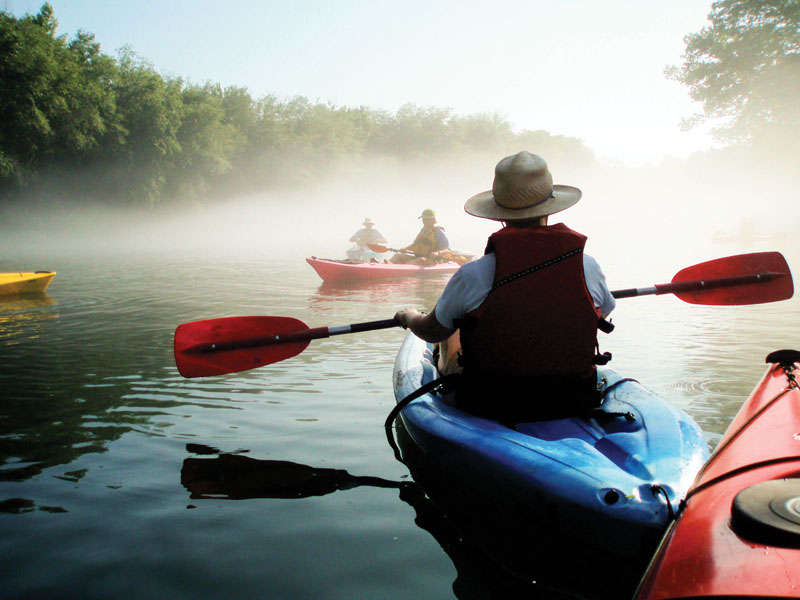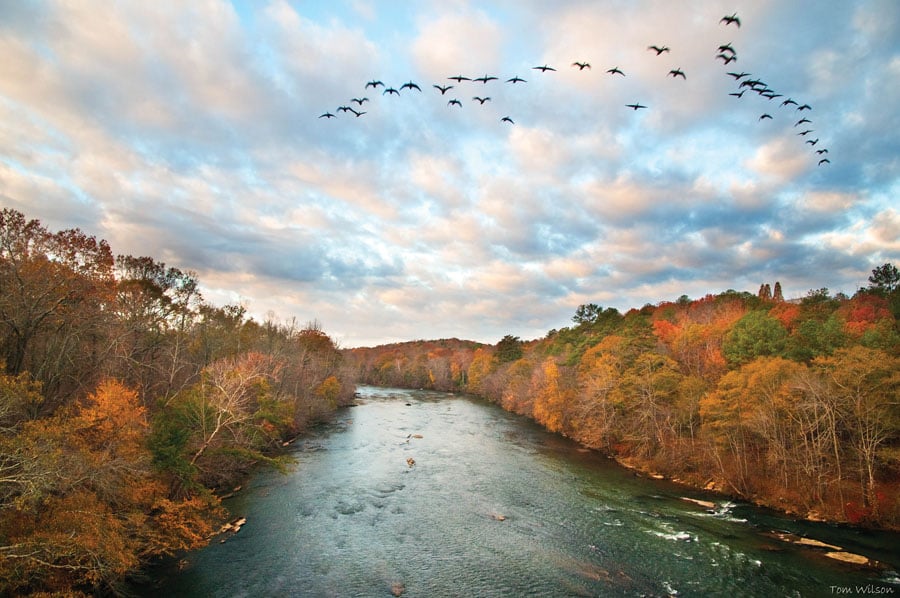Born in the mountains of North Georgia, the Chattahoochee River is the economic and ecological lifeblood of three states: Georgia, Alabama, and Florida. But not all of the water upstream finds its way downstream, and for Florida’s Apalachicola Bay, that’s a problem.
At the Georgia state line, the Chattahoochee and Flint come together to form the Apalachicola. Florida’s Apalachicola Bay is responsible for roughly 10 percent of the nation’s oyster supply, and its waters are a safe haven for sensitive species like the sturgeon, shoal bass, and the blue striped shiner. But the oyster business here is suffering, due in large part to the pitiful amount of freshwater coming into the bay from upstream.
For nearly three decades, the Apalachicola-Chattahoochee-Flint (ACF) River Basin has been at the center of a tri-state water war between Georgia, Alabama, and Florida. The basin, which provides drinking water to over four million people, including 70 percent of metro Atlanta, is a hotbed of recreation and biological diversity.
There are species that exist only here, and nowhere else in the world, like the Halloween Darter, a small fish less than five inches in length that favors the rocky shoals of the Chattahoochee and Flint rivers.
The Flint River is especially unique in that it flows unimpeded by dams for 220 miles, one of only 40 other rivers in the United States to do so. It’s also the main source of water for agriculture in southern Georgia.
It is for all of these reasons that the ACF River Basin landed at the number one spot of America’s Most Endangered Rivers in 2016. The problem has been decades in the making, and the solution will likely be, too.
“If I thought there was some silver bullet to solve this overnight, I’d pull the trigger,” says Flint Riverkeeper Gordon Rogers. “But I don’t see it.”
Tensions over the Chattahoochee finally came to a head last year, resulting in the appointment of a U.S. Supreme Court Special Master to review the case between Florida v. Georgia. In February 2017, Special Master Lancaster recommended that the Supreme Court deny Florida’s request to cap Georgia’s water use, much to the dismay of Apalachicola’s advocates. His report acknowledged that Georgia’s water conservation methods have been “remarkably ineffective,” but that ultimately, the Army Corps of Engineers, which controls Georgia’s dams and the amount of water leaving the state line, must be included in any decisions made over water use and conservation between the states. Though the ruling is not final, it is likely that the Supreme Court will agree with Special Master Lancaster’s recommendations.
The Problem
“This tiny river is asked to do a lot of things,” says Chattahoochee Riverkeeper Jason Ulseth. “It’s one of the smallest rivers in the country that provides water supply to a major metropolitan city.”
Despite Atlanta’s dependence on the Chattahoochee, the city largely treated the river as its dumping ground for decades. As metro Atlanta’s population surged during the ‘70s and ‘80s, so, too, did the amount of sewage the city was producing. So much so, in fact, that every time it rained in Atlanta, millions of gallons of untreated sewage spilled into the mainstem of the Chattahoochee.
“The river downstream of Atlanta, two-thirds of the time, did not have enough oxygen to sustain fish and wildlife,” Ulseth says. “It was literally a dying river downstream of the city.”
At the same time, a couple hundred river miles south of Atlanta in the lower part of the Flint River, center pivot irrigation entered the still-growing agricultural industry in southern Georgia. The irrigation system, which ultimately changed the way farmers farmed, was great for agriculture, but drew heavily on the underground aquifer and, consequently, the Flint River.
“Almost one billion gallons a day is coming from the Floridan aquifer when sweet corn is in, and then we get into cotton and peanuts after that. It’s just massive. That’s the only way to describe it,” says Flint Riverkeeper Gordon Rogers.

Back in Atlanta, the Chattahoochee’s troubles seemed to improve. In 1995, Chattahoochee Riverkeeper sued the city of Atlanta and demanded that the city improve its stormwater and sewage infrastructure. They won, and since then, the city has invested more than two billion dollars in updating its system. The Chattahoochee is now cleaner than it’s ever been, but the number of people who depend on its watershed only continues to grow.
“Just the fact that you have this really large metro area sitting at the top of the river basin produces a lot of tension, and then the tension is increased when you have overuse of the water in other parts of the basin,” says Southern Environmental Law Center attorney Gil Rogers. In his 15 years of experience working on the water wars case, the only change Rogers has seen is the river levels, which continue to drop. “The reality right now is that Georgia has spent decades permitting agricultural water use to the point where there is literally a permanent drought state.”
As of 2013, the state of Georgia had more than 6,700 water withdrawal permits approved for agricultural use. Unlike the state of Alabama, which has no formal water permitting or management plan, Georgia at least has some semblance of a water withdrawal permitting process, but it should be much stricter and take into account future climate change predictions, says Rogers.
As Special Master Lancaster’s recommendations in Florida v. Georgia suggest, Georgia isn’t entirely to blame for the pitiful water levels in the ACF basin. Over the course of the Chattahoochee’s 434 miles, the Army Corps of Engineers operates a series of dams and reservoirs that compound the problem. At the confluence of the Chattahoochee and the Flint is Lake Seminole, which is formed by Jim Woodruff Dam. Due to increased demand for water in Georgia’s municipalities, especially during dry spells, the Corps has resorted to sending only the bare minimum of water over the state line into the Apalachicola.
“The longer we kick it down the road, the harder it’s going to be to solve it,” says SELC attorney Rogers.
For nine months following the 2007-2008 drought, and for 13 months following the 2012 drought, the Army Corps released just 5,000 cubic feet per second (cfs) from the dam. The Apalachicola floodplain is disconnected below 8,000-10,000 cfs, which means the fisheries and oyster industry that depend on those freshwater pulses collapsed.
“That’s a perfect way to fry an estuary,” says Flint Riverkeeper Rogers. “When they [the Army Corps] flatline the Apalachicola River for months on end, it gets way too salty for way too long.”
The Army Corps recently proposed its Final Environmental Impact Statement and Water Control Manual for the ACF River Basin, which had not been updated since the ‘50s. Much to the dismay of the basin’s riverkeepers and advocates, the manual did little to improve flows in the Apalachicola. Without some major adjustments to the Corps’ control manual, in addition to compromises and commitments to water conservation and efficiency across all three states, the river basin will continue to be at risk.
“The longer we kick it down the road, the harder it’s going to be to solve it,” says SELC attorney Rogers.
The Solution
“The solution here involves private industry, local government, state government, and the Army Corps of Engineers all working together to produce good results for the citizens up and down the watershed,” says Flint Riverkeeper Rogers. “If any one of those entities is not involved in it, you’re going to have a failure.”
That philosophy is exactly what spurred the development of the non-profit ACF Stakeholders (ACFS) in 2008. The group brought together more than 50 individuals representing the water needs of cities, counties, industries, businesses, fishermen, farmers, environmental, and recreation groups from all three states. After seven years of deliberation and research, ACFS published its Sustainable Water Management Plan for the basin, one that met the basic needs of the aforementioned groups. Though the plan was submitted to each of the states, the governors hardly batted an eye.
“It’s really hard politically to make any kind of statement or take a position that would imply that you are willing to give up water or that you’re willing to put some sort of limit on how much water you’re willing to use,” says SELC attorney Rogers. “For a governor that has at most eight years in office, it’s just a lot easier to tread water, so to speak, and leave it for the next administration to solve instead of being perceived as the one to sell out his or her state’s interests.”
For now, the future of the ACF basin remains in limbo. It is almost certain that the Supreme Court’s final ruling in Florida v. Georgia will agree with Special Master Lancaster’s recommendations, which ultimately find Florida’s argument lacking sufficient proof linking Georgia’s water mismanagement to negative downstream impacts in the Apalachicola Bay. That’s largely due to the fact that Florida did not include the Army Corps, which controls the water leaving the Chattahoochee-Flint confluence at Lake Lanier into the Apalachicola, in its original lawsuit. SELC attorney Rogers is certain that, pending the final approval of the Army Corps’ control manual, another lawsuit is in the foreseeable future, likely involving Florida, Georgia, and the Army Corps of Engineers.
But no matter the litigation that ensues, without a tri-state, transboundary, multi-stakeholder management plan (like that proposed by ACFS) that requires increased water efficiency in all parts of the basin, it is likely that the industries, municipalities, and species who depend on this water will continue to pay the price.







